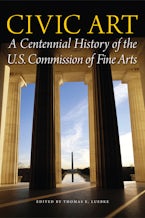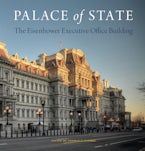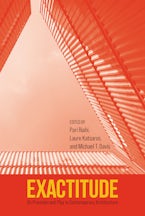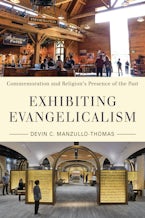- Home
- Civic Art

Civic Art
A Centennial History of the U.S. Commission of Fine Arts
Edited by Thomas E. Luebke
Published by: U.S. Commission of Fine Arts
636 Pages, 10.00 x 12.00 x 2.00 in, 424 color, 496 b&w
Other Retailers:
The establishment of this seven-member, presidentially appointed commission on design can be traced to the Senate Park Commission of 1901, whose grand plan focused on the Mall as the symbolic core of the capital—and the nation—and proposed that it be a formal, public space framed by monumental architecture to express the political aspirations of the American democracy. Comprised of distinguished architects, landscape and urban designers, artists, and lay people, the Commission of Fine Arts has worked for more than a century to promote excellence in design through changing power politics, pressures of public opinion, and prevailing aesthetic sensibilities to achieve a built environment that reflects, with grace and dignity, the history and ideals of this country. Like many other undertakings in the nation's capital, there have been exemplary successes, difficult compromises, and even blunders—whether in the design of American coins, federal buildings, overseas cemeteries, or the always-controversial national memorials.
This comprehensive history explores the evolving role of the Commission of Fine Arts in the context of the artistic, social, and political circumstances that fostered the commission's creation and the subsequent trends that have informed its decisions. As design philosophies and styles changed over the century, the commission also shifted its emphasis—from Beaux-Arts architecture and planning principles to the modernist pragmatism of midcentury, the urban redevelopment and historicist trends of the late twentieth century, and to the contemporary era characterized by issues of security, sustainability, and information technology. Organized chronologically by the periods of the commission's leadership, this illustrated book includes original essays by William B. Bushong, Arleyn Levee, Zachary Schrag, Pamela Scott, Carroll William Westfall, and Richard Guy Wilson.
Civic Art: A Centennial History of the U.S. Commission of Fine Arts provides many glimpses of the fractious, inspired, and often messy process that defines democracy in action in Washington, as revealed in the work of the commission since 1910.
Thomas Luebke has served as Secretary of the U. S. Commission of Fine Arts since 2005. He is an architect with over twenty years' experience in design, planning, and historic preservation in both public and private sectors and was the design leader in the development of the 2009 Monumental Core Framework Plan for Washington, D.C. He served previously as the executive director of the Mayors' Institute on City Design; as City Architect for Alexandria, Virginia; and as a designer for numerous award-winning projects in architectural practice. Mr. Luebke received a master in architecture degree from the Harvard University Graduate School of Design and was a visiting scholar at the American Academy in Rome in 2010. He was named a Fellow of the American Institute of Architects in 2011 and has served as president of the Washington Architectural Foundation Board, a non-profit organization of architects serving the Washington, D.C., community.
"The important work of the Commission of Fine Arts touches on questions of politics, design, urban planning, environmental planning, architectural history, and cultural history. While its work primarily concerns Washington, D.C., the capital often has served as a laboratory for what happens in the rest of the country, and this volume should appeal to both professional and lay readers interested in these varied fields."—Susan L. Klaus, author of A Modern Arcadia: Frederick Law Olmsted Jr. and the Plan for Forest Hills Gardens
"This richly illustrated history will reconnect you with the city, make you look at the built environment with new eyes, and let you wander the streets, parks and ceremonial byways of the nation's capital alert to what might have been, what might be much worse, and the convoluted process that led to the city we know today. Luebke's book immediately joins the shortlist of essential texts about Washington design and architecture."—The Washington Post
"Particularly valuable are the narrative histories for hundreds of individual buildings, parks, and monuments, often quite detailed and illustrated with multiple images. Beyond its grand scope, Civic Art is notable for its thoughtful treatment of Washington's transformations in recent decades, reacting to needs for historic preservation alongside security and sustainability. This comprehensive publication encompasses American art, architecture, urban planning, history, politics, memory, and national identity--superlatively delivering on its stated purpose of providing a foundation for future research."—Art Libraries Society of North America
"This highly detailed, monumental work is an important resource covering Washington's history and the processes that have created the capital's built culture since 1910. Highly recommended."—Choice











